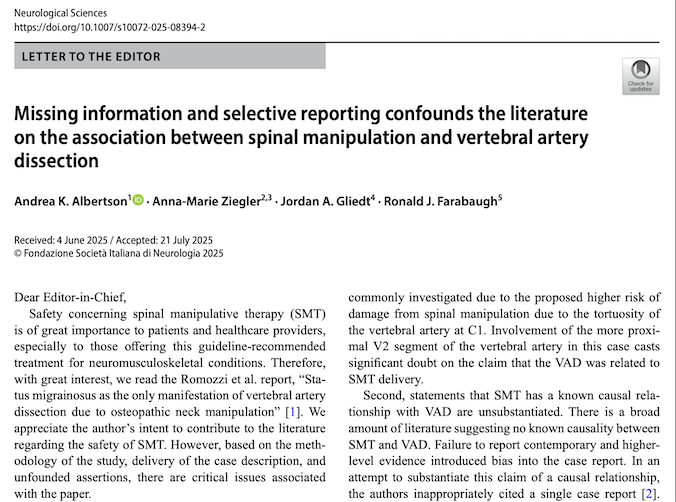Protecting Chiropractic and Patients: Validation
Written by: James Demetrious, DC, DABCO
In a recent PostGradDC Clinical Pearl post, I authored Protecting Chiropractic from Bad Science and Bias, offering a brief critique of the recent paper by Romozzi et al. [1] Although my post was informal and not peer-reviewed, it reflected my concerns about significant methodological deficiencies in their work.
Recently, my concerns received strong independent validation. In a compelling Letter to the Editor, Albertson et al. [2] wrote:
“In conclusion, this case report provides inappropriate claims of causality with unsubstantiated statements demonstrating confirmation bias, and unclear and missing information that weaken the credibility of the case. The population-based studies suggest the risk of VAD after SMT is very low and comparable to primary care encounters, which was not represented in this case report.”
Poorly written case reports represent the lowest level of scientific evidence. Meaningful scientific advancement depends upon rigorous analysis, informed critique, and open exchange. The ability to evaluate research accurately requires advanced training, clinical experience, and adherence to accepted standards of care.
Individuals admitted as experts without the necessary training, advanced education, specialization, or proven competence risk distorting prevailing scientific standards, often relying on low-quality case reports and offering flawed opinions influenced by financial incentives. These deficiencies undermine the integrity of proceedings and diminish public trust in both the medical and legal systems.
Opinions shaped by financial conflicts of interest must be fully disclosed and, when warranted, disqualified. Standards of care must be grounded in chiropractic college curricula, jurisdictional regulations, and the consensus of our professional peers, not in financial gain, personal bias, or flawed science.
I am qualified to address this matter, with credentials and experience that span clinical practice, education, research, and legal consulting:
-
Board-Certified Chiropractic Orthopedist and Diplomate, International Academy of Neuromusculoskeletal Medicine, with nearly 40 years of clinical experience.
-
Nationally Distinguished Fellow of the Academy of Chiropractic Orthopedists and the American College of Chiropractic Orthopedists.
-
Recognized Clinical Risk Management Educator and member of the esteemed National Mutual Chiropractic Insurance Company Speakers’ Bureau.
-
Accredited Postgraduate Educator, with coursework approved by:
-
American College of Chiropractic Orthopedists
-
International Academy of Neuromusculoskeletal Medicine (Maintenance of Certification)
-
PACE–Federation of Chiropractic Licensing Boards
-
NCMIC
-
American Association of Clinical Anatomists
-
-
Legal Consultant providing expert support for chiropractors nationwide.
-
Published Scholar with multiple peer-reviewed articles and editorial roles in professional journals.
-
First to Publish the causal association between fluoroquinolone antibiotics and cervical artery dissection.
-
Creator & Instructor of the only 10-hour postgraduate certification course dedicated to cervical artery dissection.
-
Founder of PostGradDC, advancing patient safety, chiropractic excellence, and professional advocacy across the United States and globally.
Throughout my career, I have witnessed the detrimental effects of poorly conducted research, often produced by individuals lacking the necessary qualifications or freedom from bias. The most effective response to such narratives is the creation and promotion of objective, high-quality, methodologically sound research that enhances patient care and professional integrity.
I am grateful to Albertson et al. and to my colleagues who remain committed to this vital work. It is through the consensus of respected experts that we achieve clarity, elevate standards, and improve healthcare.
Reference
- Romozzi et al.: https://doi.org/10.1007/s10072-025-08180-0
- Albertson et al. https://doi.org/10.1007/s10072-025-08394-2
Disclosure
The information provided in this article and all PostGradDC coursework should not be considered standards of care. We offer this information for educational purposes only. This information is not intended to be a substitute for professional medical advice, diagnosis, or treatment. Always seek the advice of your physician or qualified healthcare provider with any questions you may have regarding medical conditions or treatment. Seek the opinion of your legal representative. Errors and omissions are unintended.
Conflict of Interest Statement
Dr. James Demetrious is a board-certified chiropractic orthopedist and the founder and owner of PostGradDC (PostGradDC.com), a privately operated provider of chiropractic continuing education. He develops and delivers postgraduate coursework on clinical examination, diagnosis, patient safety, and risk management, including content related to cervical artery dissection and informed consent. Dr. Demetrious has published peer-reviewed research on these topics and provides consultation services to chiropractic physicians, attorneys, and professional organizations. This commentary was written independently and without external funding. While his educational and advocacy activities promote evidence-based chiropractic practice, the views expressed herein are his own and are based on interpretation of the current scientific literature.

PostGradDC offers advanced post-graduate chiropractic continuing education. Our founder, Dr. James Demetrious, is a distinguished board-certified chiropractic orthopedist, educator, author, and editor.
© 2025 – James Demetrious, DC, DABCO. Open Access. Unrestricted use, distribution, and reproduction are allowed in any medium, provided you give appropriate credit by citing the original author and source: Demetrious J. PostGradDC. Protecting Chiropractic and Patients: Validation. PostGradDC.com; 2025.

